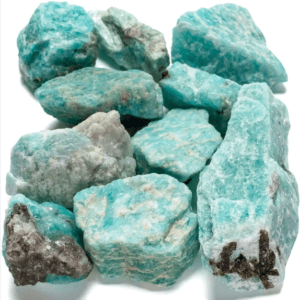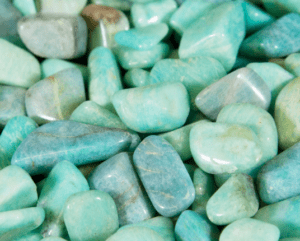AMAZONITE
AMAZONITE is very colorful and often occurs in beautiful crystal clusters. That makes it extremely popular with mineral specimen collectors.
Some of the most popular amazonite specimens are from Teller County, Colorado, where amazonite crystals are often accompanied by large prismatic crystals of smoky quartz. Large artistic specimens often sell for thousands of dollars, but you can purchase small attractive specimens more affordably. iT often occurs with other minerals such as albite feldspar, cleavelandite, quartz, and schorl tourmaline.
Amazonite occurs in color ranges of bluish green, to green, and rarely, to greenish blue. These colors can be pale, almost pastel, or vivid with a high saturation. its color is often interrupted by streaks and inclusions of white quartz or feldspar. The mineral’s color is thought to be caused by trace amounts of lead.

USES
Amazonite can be used to make cabochons, tumbled stones and other lapidary items. A popular mineral specimen with collectors, especially when they also contain feldspars or smoky quartz. Rare igneous rocks can contain significant amounts of amazonite. These have been used as a ornamental stones.
MOHS HARDNESS
6 – 6.5
LUSTER
Vitreous
CHEMICAL COMPOUND
Microline Feldspar

WHERE TO FIND
Amazonite is found in small deposits in several parts of the world. These deposits are found in the United States, Afghanistan, Australia, Brazil, Canada, China, Ethiopia, Madagascar, Namibia, Norway, Poland, Russia, and Sweden.
In the United States, the area around Pike’s Peak, Colorado and Amelia Courthouse, Virginia produce beautiful, gem-quality amazonites.
DIAGNOSTIC PROPERTIES
Its green to bluish green in a range of saturations and tones. Two directions of cleavage intersecting at close to 90 degrees. Consistent hardness, specific gravity and pearly luster on some cleavage faces.